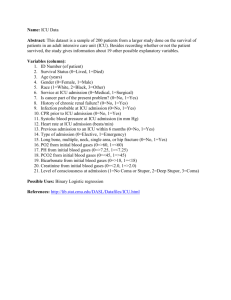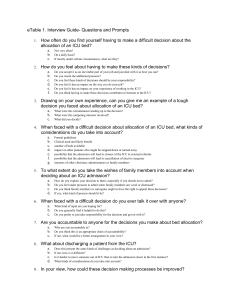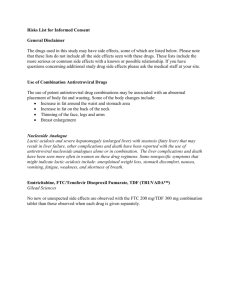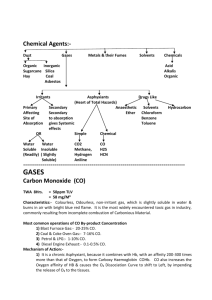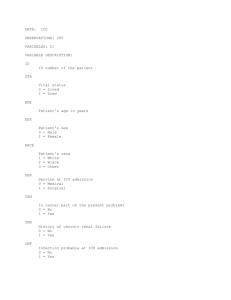early graft function and carboxyhemoglobin level in liver
advertisement
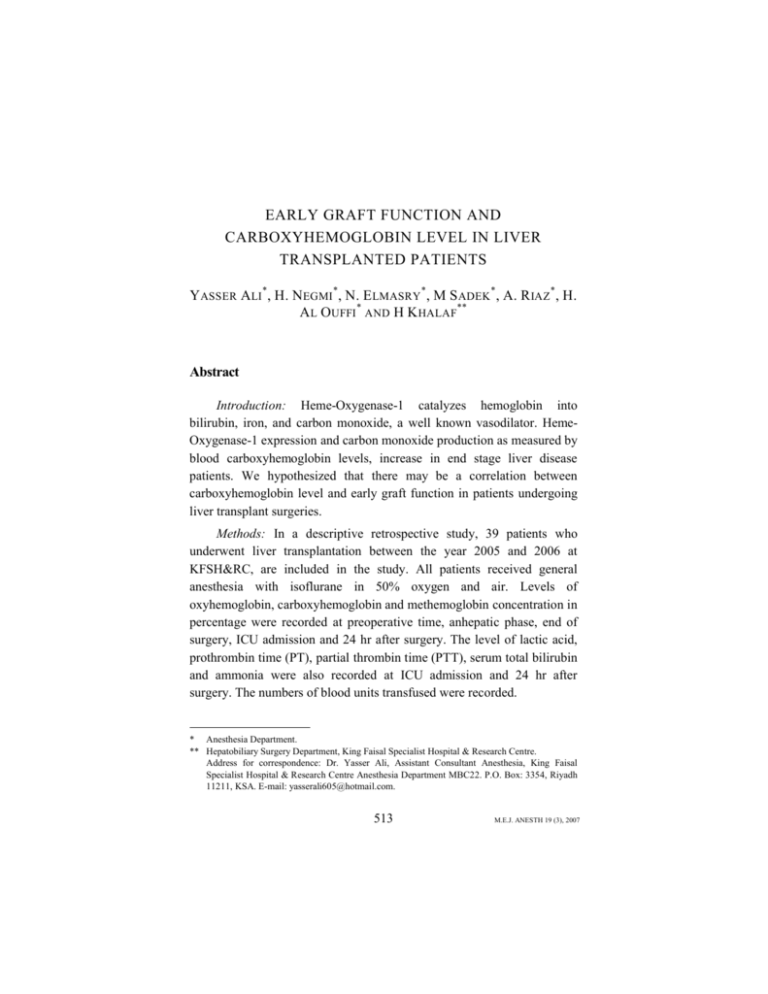
EARLY GRAFT FUNCTION AND CARBOXYHEMOGLOBIN LEVEL IN LIVER TRANSPLANTED PATIENTS Y ASSER ALI*, H. NEGMI*, N. ELMASRY*, M S ADEK*, A. R IAZ*, H. AL OUFFI * AND H K HALAF** Abstract Introduction: Heme-Oxygenase-1 catalyzes hemoglobin into bilirubin, iron, and carbon monoxide, a well known vasodilator. HemeOxygenase-1 expression and carbon monoxide production as measured by blood carboxyhemoglobin levels, increase in end stage liver disease patients. We hypothesized that there may be a correlation between carboxyhemoglobin level and early graft function in patients undergoing liver transplant surgeries. Methods: In a descriptive retrospective study, 39 patients who underwent liver transplantation between the year 2005 and 2006 at KFSH&RC, are included in the study. All patients received general anesthesia with isoflurane in 50% oxygen and air. Levels of oxyhemoglobin, carboxyhemoglobin and methemoglobin concentration in percentage were recorded at preoperative time, anhepatic phase, end of surgery, ICU admission and 24 hr after surgery. The level of lactic acid, prothrombin time (PT), partial thrombin time (PTT), serum total bilirubin and ammonia were also recorded at ICU admission and 24 hr after surgery. The numbers of blood units transfused were recorded. * Anesthesia Department. ** Hepatobiliary Surgery Department, King Faisal Specialist Hospital & Research Centre. Address for correspondence: Dr. Yasser Ali, Assistant Consultant Anesthesia, King Faisal Specialist Hospital & Research Centre Anesthesia Department MBC22. P.O. Box: 3354, Riyadh 11211, KSA. E-mail: yasserali605@hotmail.com. 513 M.E.J. ANESTH 19 (3), 2007 YASSER ALI ET. AL 514 Results: 39 patients were included in the study with 13/39 for living donor liver transplant (LDLT) compared to 26/39 patients scheduled for deceased donor liver transplant (DDLT). The mean age was 35.9 ± 16.9 years while the mean body weight was 60.3 ± 20.9 Kg. Female to male ratio was 21/18. The median packed red blood cell (PRBC) units was 4 (Rang 0-40). There was a significant increase in carboxyhemoglobin level during the anhepatic phase, end of surgery and on ICU admission compared with preoperative value (p<0.005). However, there was insignificant changes in methemoglobin level and significant decrease in oxyhemoglobin levels throughout the study period compared to the preoperative value (p<0.005). The changes in carboxyhemoglobin level on ICU admission and 24 hrs postoperatively were positively correlated with the changes in serum total bilirubin and prothrombin time (R = 0.35, 0.382, 0.325 and 0.31) respectively p<0.05) but not with the changes in serum lactic acid. The same strong correlation was found when analysing LDLT and DDLT patients separately between carboxyhemoglobin concentration and PT and total bilirubin while still the correlation with lactic acid was weak. There was no correlation between average perioperative carboxyhemoglobin concentration during different timing of measurements and average units of transfused blood (R = -0.02) p>0.05. Conclusion: The changes in carboxyhemoglobin level significantly correlate with the changes in graft functions particularly prothrombin time and serum total bilirubin and may be used as an early, rapid and simple test for early evaluation of graft function. Introduction While the hepatologist may use the prothrombin ratio or perhaps plasma pre-albumin concentrations (half-time 1-2 days) as a marker of the well-being of the liver for patients in acute liver failure, the chronic liver patient is best monitored by measurement of plasma enzymes (transaminases and gamma-glutamyl transpeptidase), serum bilirubin, and the plasma protein albumin (with its longer half-time of about 20 days). Traditionally, the anesthesiologist has assessed the effects of drugs EARLY GRAFT FUNCTION AND CARBOXYHEMOGLOBIN LEVEL IN LIVER... 515 on the liver by measurement of the release into the blood or plasma of hepatic enzymes (such as the transaminases, alkaline phosphatase, and gamma-glutamyl transpeptidase, and more specific enzymes such as ornithine transcarbamoylase and 5'-nucleotidase)1. More recently, attention has been turned to pharmacological tests of liver function-based on either the clearance of marker substances or measurement of the pharmacological effects of drugs that are wholly eliminated by the liver17,18. Humans produce endogenous carbon monoxide (CO) through heme catabolism(1). Heme Oxygenase-1 (HO-1) is the rate limiting enzyme in heme catabolism with the production of iron, bilirubin and carbonmonoxide2. Carbon-monoxide will pass cell out to blood stream combined with hemoglobin to form carboxyhemoglobin (COHb) and be eliminated by the lungs. The affinity of hemoglobin for CO is more than 200 times as great as its affinity for oxygen and shifts the oxyhemoglobin dissociation curve to the left1. CO binds to cell heme proteins, such as myoglobin or cytochrome oxidase, and interferes with their function4. Heme oxygenase-1 is not induced only by its substrate heme but also by various types of oxidative stress3-5 including anesthesia, surgery, sepsis and end organ function. Also heme oxygenase induction occurs in patients with hepato-pulmonary syndrome with carbon monoxide production that ultimately lead to vasodilatation6. During out daily work in King Faisal Specialist Hospital & Research Centre with patients undergoing liver transplant, we noticed an increase in COHb level peri-operatively. We hypothesized that there may be a correlation between carboxyhemoglobin (COHb) level and early graft function in liver transplanted patients. Patients and Methods In descriptive retrospective study, 39 patients scheduled for liver transplant between the year 2005 and 2006 in KFSH & RC are included M.E.J. ANESTH 19 (3), 2007 516 YASSER ALI ET. AL in the study. All patients included in the study received general anesthesia with isoflurane in O2 50% and atracurium as muscle relaxant. Patients excluded from the study are those with no sufficient data, associated sepsis, chronic lung disease or combined organ failure. Levels of oxyhemoglobin, carboxyhemoglobin and methemoglobin concentration in percentage were recorded at preoperative time, anhepatic phase, end of surgery, ICU admission and 24 hr after, using blood gas analyzer (Chirona Diagnostics 865). Also, changes in prothrombin time (PT), partial thrombin time (PTT), serum bilirubin, ammonia and lactic acid were recorded at ICU admission and 24 hr after. The average number of blood units transfused were also recorded and correlated with the average peri-operative COHb. Correlation between changes in carboxyhemoglobin level and PT, PTT, total bilirubin, serum ammonia and lactic acid, were done for all patients included and also for patients with LDLT and DDLT separately. Statistical analysis Results were expressed as mean ± SD, analyzed using tests of significance to identify the variables significantly to differences in different measurement times: Paired t-test, student t-test and Pearson correlation coefficient. Statistical significance correlation was considered at the level of p<0.05. Results There was significant increase in carboxyhemoglobin concentration during anhepatic phase, end of surgery and ICU admission (p = 0.001, 0.001 and 0.007 respectively) while there was insignificant decrease at 24 hr postoperatively (p = 0.24) compared to the preoperative change (Fig. 1 and Table 1). EARLY GRAFT FUNCTION AND CARBOXYHEMOGLOBIN LEVEL IN LIVER... 517 Fig. 1 Perioperative changes in carboxyhemoglobin concentration Carboxyhemoglobin (%) Perioperative Changes in Carboxyhemoglobin 3 2.5 2 1.5 1 0.5 0 Preop Anhepatic End of Surgery ICU admission 24 h Postop Measurement Times AGE Table 1 Demographic and operative data 35.9 ± 16.9 40*(5-58) SEX Weight (Kg) Surgery Time (h) 18 M/2 1 F 60.3 ± 20.9 62* (12-91) 10.3 ± 3.2 Anesthesia Time (h) 11.2 ± 2.4 Packed Red Blood Cells (PRBs) Unit 7.1 ± 7.7 4(0-40)* Data expressed in Mean ± SD) * Median (Range) There were perioperative insignificant changes in methemoglobin concentration compared to the preoperative readings. Table 2 represent the changes in methemoglobin and oxyhemoglobin concentration, there was significant decrease in oxyhemoglobin concentration during anhepatic phase, end of surgery, ICU admission and 24 hr postoperatively when compared with the preoperative change (p = 0.027, 0.0414, 0.0316 and 0.0443 respectively). M.E.J. ANESTH 19 (3), 2007 YASSER ALI ET. AL 518 Table 2 Perioperative Changes in Carboxyhemoglobin, Methemoglobin and Oxyhemoglobin levels Variables Time of Mean ± SD P Value Measurement Preoperative 1.2 ± 0.9 Anhepatic 2.66 ± 1.2 0.0001* Carboxyhemoglobin Concentration End of Surgery 2.1 ± 1.16 0.0001* (COHb %) ICU Admission 1.75 ± 0.94 0.007* 1.1 ± 0.91 0.24 24 h Postoperative Methemoglobin Concentration (MetHb %) Oxyhemoglobin Concentration (OxyHb %) Preoperative 0.43 ± 23 Anhepatic End of Surgery ICU Admission 24 h Postoperative Preoperative Anhepatic End of surgery ICU Admission 24 h Postoperative 0.38 ± 0.24 0.44 ± 0.26 0.42 ± 0.36 0.45 ± 0.35 97.07 ± 2.7 94.64 ± 6.64 94.8 ± 6.67 95.6 ± 4.01 95.07 ± 6.00 0.231 0.737 0.901 0.757 0.027* 0.0414* 0.0316* 0.0443* Data expressed in mean ± SD. * Significant when P<0.05. The change in prothrombin time and serum ammonia were insignificant at ICU admission and 24 hr postoperatively (p = 0.2304, 0.20 and 0.5494 respectively), while there was significant prolongation of PTT only at ICU admission (p = 0.0026). There was significant decrease in total serum bilirubin and lactic acid levels at 24 hr postoperatively when compared with ICU admission value (p = -.0047 and 0.0001 respectively) (Table 3). EARLY GRAFT FUNCTION AND CARBOXYHEMOGLOBIN LEVEL IN LIVER... 519 Table 3 Perioperative changes in early graft function as PT, PTT, Total bilirubin, serum ammonia and serum lactic acid Time of Measurement Mean ± SD P Value Prothrombin Time (PT)Seconds Partial thromboplastin time (PTT) Seconds Bilirubin (mg/L) Ammonia (mg/L) Lactic acid (mg/L) Preoperative 23.46 ± 13.9 ICU Admission 24 h postoperative Preoperative 26.82 ± 11.25 24.17 ± 10.41 56.97±23.32 0.2304 0.20 ICU Admission 24 h postoperative ICU Admission 24 h postoperative ICU Admission 24 h postoperative ICU Admission 24 h postoperative. 72.15 ± 21.55 60.59 ± 25.31 164.56 ± 110.31 129.9 ± 103.3 54.38 ± 29.99 51.61 ± 25.24 4.07 ± 2.78 1.76 ± 1.15 0.0026** 0.5056 0.0047* 0.5494 0.0001** Data expressed as mean ± SD. * Significant when P<0.05. ** Significant when P<0.005 There were strong correlations between changes in carboxyhemoglobin concentration and changes in PT and total bilirubin at ICU admission and 24 hr postoperatively (R = 0.350, 0.382, 0.325 and 0.31 respectively, p<0.05) while there were weak correlation with lactic acid (R = -0.048 and 0.098 respectively) and no correlation with the changes in serum ammonia (R = -0.021 and -0.065 respectively). (Table 4, Fig. 2 and curves in Fig. 3, 4). Table 4 Represent Pearson Correlation Coefficient between carboxyhemoglobin concentration (on ICU admission and 24 hr postoperatively) and changes in prothrombin, partial thromboplastin, total serum bilirubin, serum ammonia and lactic acid PT PTT T. Bil Ammonia Lactic A. COHb% ICU admission COHb% 24 hr PO R P R P 0.325 0.043* 0.31 0.044* 0.225 0.81 0.0255 0.8775 0.350 0.0288* 0.382 0.016* -0.021 0.896 -0.065 0.6924 -0.048 0.767 0.098 0.551 * Significant when P<0.05. M.E.J. ANESTH 19 (3), 2007 YASSER ALI ET. AL 520 Fig. 2 Represent correlation between COHb and PT, PTT, total bilirubin, serum ammonia and lactic acid Pearson correlation coeffient Correlation between COHb and graft functions 0.4 0.35 0.3 0.25 0.2 0.15 0.1 0.05 0 COHb on ICU admission COHb on 24 hr postop. PT PTT Bil Amonia Lactic Acid Fig. 3 Correlation curve between carboxyhemoglobin level and serum bilirubin EARLY GRAFT FUNCTION AND CARBOXYHEMOGLOBIN LEVEL IN LIVER... 521 Fig. 4 Correlation curve between carboxyhemoglobin level and prothrombin time It was found out that there was no correlation between average perioperative carboxyhemoglobin levels during different timing of measurements and average units of blood transfused (R = -0.02) p>0.05. The same strong correlation was found when analysing LDLT and DDLT patients separately between carboxyhemoglobin concentration and PT and total bilirubin while still the correlation with lactic acid was weak. (Fig. 5, 6) Fig. 5 Represent correlation between COHb and PT, PTT, total bilirubin, serum ammonia and lactic acid in LDLT patients Pearson Corrolation Coeffient Correlation Betwwen COHb and graft function Variables in LDLT patients 1 0.8 0.6 COHb on ICU Admission 0.4 COHb on 24 hr 0.2 0 PT PTT Bilirubin Amonia Lactic Acid Graf Function Variables M.E.J. ANESTH 19 (3), 2007 YASSER ALI ET. AL 522 Fig. 6 Represent correlation between COHb and PT, PTT, total bilirubin, serum ammonia and lactic acid in DDLT patients Pearson Correlation Coeffient Correlation between COHb and graft functiion variables in DDLT patients 0.5 0.4 0.3 COHb on ICU Admission 0.2 COHb on 24hr 0.1 0 PT PTT Bilirubin Amonia Lactic Acid Graft Function Variables Discussion Carboxyhemoglobinemia is usually associated with exposure to exogenous carbon monoxide (CO) and is the leading cause of injury and death due to poisoning worldwide1. However the sole physiologic (endogenous) source of CO is heme degradation in the body. Heme oxygenase-1 is a microsomal enzyme that regulates the cellular content of heme. It catalyzes the rate-limiting step in the oxidative catabolism of heme to yield equimolar quantities of biliverdin, CO, and iron. Biliverdin is then reduced by the biliverdin reductase to bilirubin2. As a consequence to this process, carboxyhemoglobin (COHb) concentration is increased. The observation of increased concentration of COHb during anhepatic phase and also through the reperfusion phase were analysed and investigated in the present study. The observation of high COHb concentration during different phases of liver transplant surgery could be related to the Heme-1 oxygenase induction by the oxidative stress of surgery and anesthesia with the production of bilirubin and COHb. This was supported by study done by Masao Hayashi et al7, who stated that the heme-1 oxygenase enzyme is induced by oxidative stress not only by surgery but also by sepsis, systemic inflammation and organ dysfunction. They stated also that COHb could be used as a marker for oxidative stress. Also it was EARLY GRAFT FUNCTION AND CARBOXYHEMOGLOBIN LEVEL IN LIVER... 523 demonstrated that heme oxygenase-1 is induced in the liver of a rate model sepsis8. In another study by Bellamy et al14, they stated that, extra-hepatic effects of hepatic reperfusion result in hemodynamic deterioration and biochemical responses similar to those seen in sepsis. The causes of this response are poorly defined; animal models of ischemia-reperfusion syndrome have demonstrated increased expression of tumour necrosis factor-a (TNFa)15. In these models, TNFa and hemodynamic changes resemble those seen in sepsis, where release of TNFa and a range of interleukins (IL) are associated with reduction in systemic vascular resistance and an increased cardiac index and hence induction of hemoxygenase-1 and increased level of COHb. Also in another study, the changes in O2 consumption (VO2), and return of baseline VO2 has been used to index early graft function in the year 200111, where VO2 is decreased during the anhepatic stage largely due to loss of hepatic metabolism. Alterations in metabolic rate also occur as the graft is perfused with oxygenated blood and becomes metabolically active. It has been shown previously that an increase in whole body oxygen consumption occurs after reperfusion which may reflect oxygen uptake by the graft12,13. The association of significant decrease in oxyhemoglobin and increase in COHb during anhepatic and reperfusion phase in the present study, can give an explanation to the changes in VO2 during the same phases in the study done by Shangraw et al11. The decrease in VO2 during the anhepatic phase was not only attributed to the drastic decrease in hepatic metabolism, but to the global decrease in O2 available secondary to the decrease in oxyhemoglobin and cardiac index. The correlation between total bilirubin in the blood and the concentration of carboxyhemoglobin could be explained by the continuous induction of heme oxygenase-1 by the failing graft11 while good functioning graft are associated with less enzyme induction and less bilirubin and COHb production. Similar to the present results, Orii et al16 found that the lactate levels M.E.J. ANESTH 19 (3), 2007 524 YASSER ALI ET. AL increased before reperfusion and began to decrease after reperfusion. In contrast to Patrick Zieman et al, and although bilirubin production increases with the increase in the units of blood transfused9, we found that there was no correlation between average perioperative carboxyhemoglobin levels during different timing of measurements and average units of blood transfused (R = -0.02) p>0.05. The results in the present study are supported by Hirano K et al10 study, where it stated that persistent hyperbilirubinemia in small-for-size grafts and concomitant COHb reflect both parenchyma and Kupffer cell dysfunction. We conclude that COHb could be an early, simple and rapid marker to liver graft function. However, further study is recommended to find out possible correlation between COHb and late graft function. Acknowledgment The authors gratefully acknowledge Abd Elmonem Aldardyry, PhD, for his statistical assistance. EARLY GRAFT FUNCTION AND CARBOXYHEMOGLOBIN LEVEL IN LIVER... 525 References 1. BRITTENHAM GM: Disorders of iron metabolism: iron deficiency and overload. In: Hoffman R, Benz EJ Jr, Shattil SJ et al, eds. Hematology: Basic Principles and Practice. 3rd ed. Philadelphia: Churchill Livingstone, 397-428, 2000. 2. THOM SR: Hyperbaric-oxygen therapy for acute carbon monoxide poisoning. N Engl J Med; 347:1105-6, 2002. 3. STEVENSON DK, VREMAN HJ: Carbon monoxide and bilirubin production in neonates. Pediatrics; 100:252-4, 1997. 4. PIANTADOSI CA: Carbon monoxide poisoning. N Engl J Med; 347:1054-5, 2002. 5. ERNST A, ZIBRAK J: Current concepts: carbon monoxide poisoning. N Engl J Med; 339:1603-8, 1998. 6. ARGUEDAS MR, DRAKE BB, KAPOOR A, FALLON MB: Carboxyhemoglobin levels in cirrhotic patients with and without hepatopulmonary syndrome. Gastroenterology; 128(2):328-33, 2005. 7. MASO HAYASHI, TORU TAKAHASHI, HIROSHI MORIMATSU, ET AL: Increased carbon monoxide concentration in exhaled air after surgery and anesthesia. Anesth Analg; 99:444-8, 2004. 8. SUZUKI T, TAKAHASHI T, YAMASAKI A, ET AL: Tissue specific gene expression of heme oxygenase-1 (HO-1) and non-specific delta-aminolevulinate synthase (ALAS-N)in a rate model of septic multiple organ dysfunction syndrome. Biochem Pharmacol; 60:275-83, 2000. 9. PATRICK ZIEMANN-GIMMEL, DAVID E SCHWARTZ: Increased Carboxyhemoglobin in a Patient with a Large Retroperitoneal Hematoma. Hepatogastroenterology; 50(54):1745-8, Nov-Dec, 2003. 10. HIRANO K, SATO Y, KOBAYASHI T, ET AL: Carbon monoxide hemoglobin and bilirubin metabolism in adult living-related liver transplantation. Liver Transpl; 8(4):391-6, Apr, 2002. 11. SHANGRAW, ROBERT E ROBINSON, STEPHEN T: Oxygen Metabolism During Liver Transplantation: The Effect of Dichloroacetate; Anesth Analg; 85:746-52, 1997. 12. SVENSSON KL, PERSSON H, HENRIKSSON BA, KARLBERG I, SONANDER H, LUNDHOLM K, STENQVIST O, SCHERSTEN T: Whole body gas exchange: amino acid and lactate clearance as indicators of initial and early allograft viability in liver transplantation. Surgery; 105:472-480, 1989. <ldn>! 13. STELTZER H, TUCHY G, HIESMAYR M, MULLER C, GERMANN P, ZIMPFER M: Peri-operative liver graft function: monitoring using the relationship between blood glucose and oxygen consumption during anaesthesia. Anaesthesia; 47:955-958, 1992. <ldn>! 14. BELLAMY MC, GALLEY HF, WEBSTER, NR: Changes in inflammatory mediators during orthotopic liver transplantation. Br. J. Anaesth; 79:338-341, 1997. 15. KNIGHT KR, ANGEL MF, LEPORE DA, ABBEY PA, ARNOLD LI, GRAY KA, MELLOW CG, O'BRIEN BM: Secondary ischaemia in rabbit skin flaps: the roles played by thromboxane and free radicals. Clinical Science; 80:235-240, 1991. 16. ORII, RYO, SUGAWARA, YASUHIKO, HAYASHIDA, MASAKAZU, ET AL: Lactate is Correlated with the Indocyanine Green Elimination Rate in Liver Resection for Cirrhotic Patients. Anesthesia and Analgesia; 92:1064-1070, 2001. 17. SEAR JW, PRYS-ROBERTS C, DYE A: Hepatic function after anaesthesia for major vascular reconstructive surgery: a comparison of four anaesthetic techniques. Br J Anaesth; 55:603-7, 1983. 18. Sear JW: Assessment of liver function: its application to outcome from liver transplantation. Br J Anaesth; 88(6):757-760, 2002. M.E.J. ANESTH 19 (3), 2007 526 YASSER ALI ET. AL
